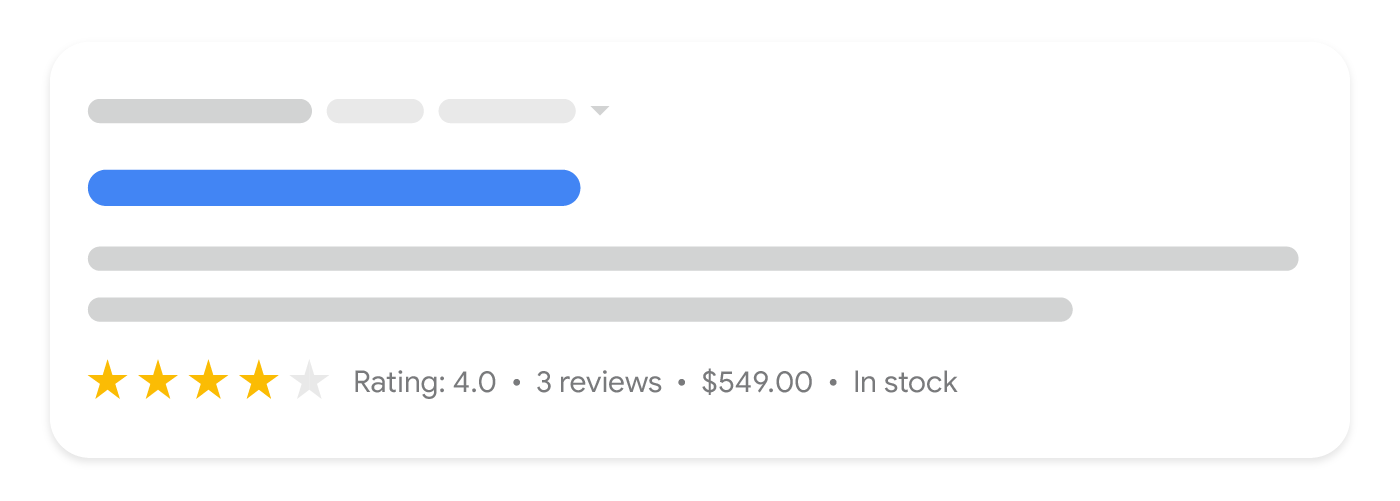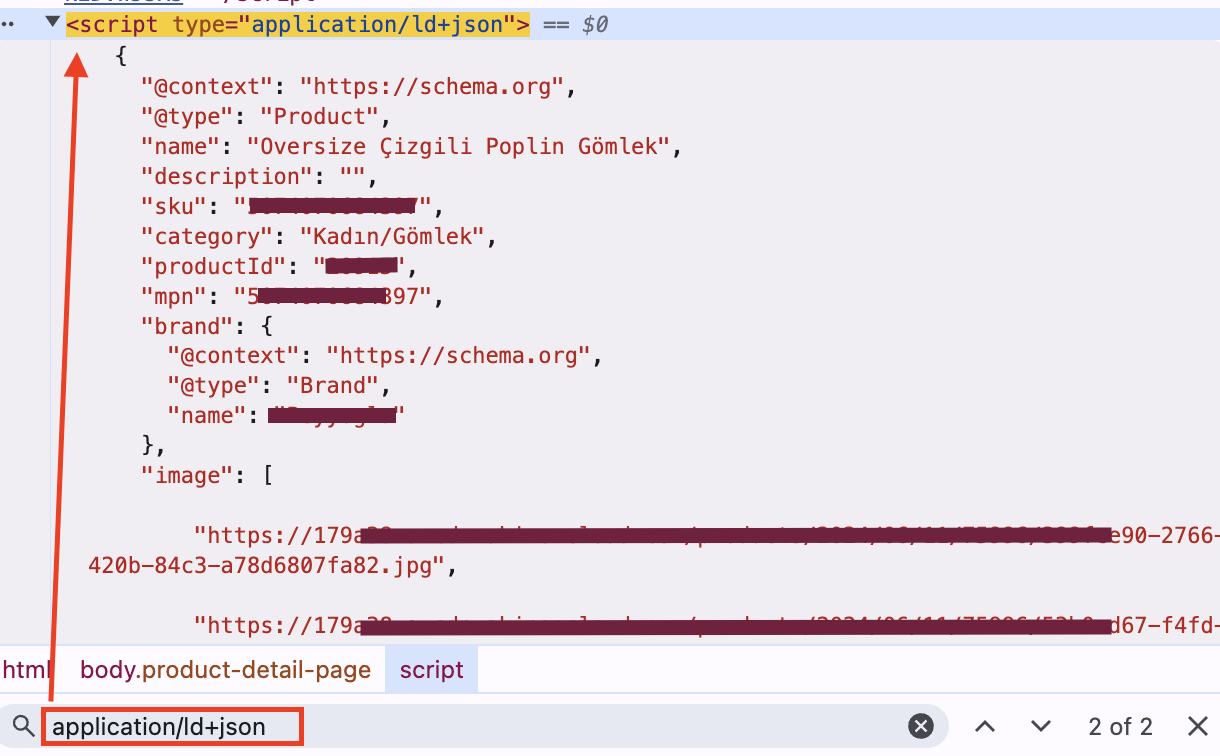
Furkan Çerkovanlı
May 8, 2025What is Product Snippet (Product Schema) and How to Create It?

Product snippets are structured data formats that make e-commerce pages listed on search engines like Google appear more attractive and informative. These snippets can include information such as price, stock status, rating scores, and product images. When used correctly, they can increase the likelihood that users will choose your site among search results.
These snippets are generally created using Schema.org structured data. With schema markup in JSON-LD, Microdata, or RDFa format added to HTML pages, search engines can better understand your content and index it accurately.
Steps to Create a Product Snippet
Select Schema.org Structured Data: You need to create an appropriate product snippet using one of the formats: JSON-LD, Microdata, or RDFa. The most comprehensive source for this is schema.org.
- Support from Google Resources: Google, the most widely used search engine, publicly shares the metrics it approves regarding structured data. Click here for Google’s recommended Product Snippet procedure.
- Define Basic Information: For high-performing snippets, include key data such as product name, price, stock status, and ratings.
- Integrate into HTML Page: Optimize your page for search engines by embedding structured data into your HTML. The more dynamic the implementation, the easier your job becomes. Set it up so information is automatically pulled when products are added.
- Validate with Google Rich Results Test Tool: This tool directly identifies errors and issues in the structured data. Check the functionality of the schema markup using the Google Rich Results Test Tool.<
Required HTML and Schema Markup for Product Snippets
On product pages, the required information that Google wants to retrieve includes “Product Name” and at least one of the following: “review”, “aggregateRating”, or “offers”.
Here is an example of a product snippet in JSON-LD format that you can add to your HTML page:
script type="application/ld+json">
{
"@context": "https://schema.org/",
"@type": "Product",
"name": "Samsung Galaxy S24",
"image": "https://example.com/images/samsung-galaxy-s24.jpg",
"description": "High-performance next-generation smartphone.",
"brand": {
"@type": "Brand",
"name": "Samsung"
},
"aggregateRating": {
"@type": "AggregateRating",
"ratingValue": "4.7",
"reviewCount": "1500"
},
"offers": {
"@type": "Offer",
"priceCurrency": "TRY",
"price": "19999",
"availability": "https://schema.org/InStock"
}
}
This code provides search engines like Google with basic product information to generate rich snippet appearances in search results. For Google’s recommended Product Snippet procedure, click here.
Where Should You Place Product Snippets?
Product Snippets (Product Schema Markup) are usually created in JSON-LD format and added to the website. This is also the recommended method in Google’s documentation. Google’s guideline for placing a product snippet is as follows:
| JSON LD* (Recommended) | JavaScript representation placed in the script tag in the head or body of the HTML page. The markup is not interspersed with visible text. This makes it easier to express nested data items such as the PostalAddress value of a MusicVenue element. |
| Microdata | Like RDFa, it uses HTML tag attributes to name the properties you want to mark as structured data. It is generally used in the body but can also be in the head section. |
| RDFa | An HTML5 extension supporting linked data by providing attributes for HTML elements corresponding to content visible to the user. RDFa is commonly used in both the head and body sections of the HTML page. |
In summary, you can place your product snippets or structured data in the head or body sections.
*Expert Advice: Since HTML is read from top to bottom, placing it in the head section is more readable and robust.
How to Check Product Snippets?
There are several ways to check a product snippet or structured data in general. We’ll detail these methods below.
- Google Rich Results Test Tool
- Dev Tools Inspect Area
- Source Code
Google Rich Results Test Tool
The Google Rich Results Test Tool lets you test whether a page’s structured data qualifies for rich results in Google Search. This tool allows you to see whether specific data types like product data are correctly processed and helps identify errors.

You can start the analysis by pasting the URL of the page you want to test or by directly pasting the HTML code into the tool. It lists the structured data types found and explicitly indicates warnings or errors. It also provides a preview of how correctly defined data will appear in Google search results.
Steps to test a Product snippet using Google Rich Results:
- Go to Google Rich Results Test Tool: Visit https://search.google.com/test/rich-results
- Paste the product page URL you want to check: Or alternatively paste the HTML code directly.
- Click the "Run Test" button: Google will start analyzing the structured data.
- Review the test results: Structured data types found on the page (e.g., “Product”) will be listed.
- Check for errors and warnings: Missing, incorrect, or recommended fields will be clearly displayed. For example, it will warn you if "price" is missing.
- View the product snippet preview: If the structured data is correct, a sample preview will be shown.
- Make necessary corrections and retest: After fixing the errors, rerun the test to ensure accuracy.
Dev Tools Inspect Area
Browser developer tools (Dev Tools) are useful to directly see how structured data is integrated into the page. Open the page and right-click, then select “Inspect” to access the HTML structure.

In this area, you can directly view structured data in JSON-LD format defined with the script type="application/ld+json" tags. You can check whether necessary fields like product name, price, and stock status are correctly defined.
To check Product Snippet via Dev Tools:
- Open the Devtools Inspect area on the page (F12)
- Press Control + F in the Elements tab to open the search bar.
- Search for "application/ld+json"
- Click the results and copy the code to a text editor to review the snippet.
Checking via Source Code
You can view the source code (Ctrl+U or right-click “View Page Source”) to directly see the placement of structured data in the HTML. This method lets you check both JSON-LD and other structured data formats like Microdata.
In the source code, verify whether structured data is correctly defined with appropriate tags and content. It’s important for meeting search engine expectations and ensuring all required fields are complete and up to date.
Required Metrics in Product Snippets
Google supports the use of structured data so that product pages can be shown as rich snippets in search results. However, to display these snippets correctly and effectively, certain metrics must be used. Below is a table listing the main metrics used in product snippets and their functions:
| Metric Name | Required? | Description (Details) |
| name | Required | Specifies the name of the product. Without this metric, a product snippet cannot be created. |
| image | Required | URL of the product image. Required for image display in the snippet. |
| description | Not Required | Provides a short description of the product. Optional but recommended. |
| sku | Not Required | Specifies the product’s stock code. Useful for inventory tracking and identification. |
| brand | Not Required | Indicates the brand the product belongs to. Recommended for known brands. |
| offers | Required | Contains information such as product price, stock status, and seller. Required for price display in snippets. |
| offers.price | Required (within offers) | Specifies the product’s sale price. |
| offers.priceCurrency | Required (within offers) | Indicates the currency of the price (e.g., TRY, USD). |
| offers.availability | Not Required | Specifies stock status (e.g., InStock, OutOfStock). |
| aggregateRating | Not Required | Shows the average rating based on user reviews. Builds trust. |
| review | Not Required | Contains user reviews about the product. Important for social proof. |
| gtin / mpn | Not Required | The product’s global identifier. Especially important for Google Shopping. |
Product Snippet Applications in Different Industries
The use of product snippets in different industries is an important SEO element that directly affects how businesses reach their target audience. Since each industry has unique needs and user expectations, properly structured product snippets ensure better visibility in search engines.
For example, while technical features and ratings are prominent in the electronics industry, size and color options come forward in the fashion sector. In the food industry, content details and expiration dates may be critical for users. Therefore, creating a product snippet strategy tailored to each sector improves user experience and increases organic traffic.
- Electronics: For phones, computers, and other tech products – price, rating, and stock info.
- Fashion: For clothing and shoes – size, image, color, and stock availability.
- Food: For grocery items – price, ingredients list, and expiration date.
SEO Advantages of Product Snippets
Product snippets are a type of structured data that enhance SEO performance by making search engine results more eye-catching. These snippets provide critical product information (price, stock status, ratings, etc.) directly in the search results, offering a major advantage for e-commerce sites.
When applied correctly, snippets not only increase your site’s click-through rate (CTR) but also boost organic traffic and conversion rates. Product snippets are a crucial part of SEO strategies and a powerful way to stand out in a competitive e-commerce environment.
Impact of Snippets on Click-Through Rate (CTR)
Rich snippets attract user attention by appearing more visually prominent in organic search results. Pages displaying price, images, and rating information receive more clicks, increasing CTR. When users find key product details directly in search results, the likelihood of clicking on a product of interest increases. In competitive sectors, snippet use can make a noticeable difference in click-through rates.
Additionally, the extra information provided by snippets improves relevance for search queries, increasing the time users spend on your page and reducing bounce rates – offering further SEO benefits.
How Product Snippets Contribute to Organic Traffic
With better visibility and increased clicks, e-commerce sites can grow their organic traffic. Presenting product details directly improves user experience and can increase sales conversion rates. When users can access info like price, stock status, reviews, and descriptions from search results, they’re guided straight into the buying journey.
Moreover, search engines tend to rank pages with high user engagement and click-through rates higher. This helps snippet-using pages attract more organic traffic and boost brand authority in the long run. Properly structured snippets, especially those optimized for Google’s Featured Snippet or other special result formats, can exponentially increase organic reach.
More resources

5 Ways to Accurately Measure Sales Impact with Google MMM
Google MMM (Marketing Mix Modeling) is one of the most powerful statistical methods for understandin...

ChatGPT Shopping Research: An AI-Powered Shopping Assistant
ChatGPT Shopping Research is an AI-powered shopping assistant that accelerates users' shopping resea...

Data-Driven Tactics to Build Customer Loyalty After Black Friday
Customer loyalty is the most valuable outcome of the Black Friday period, as short-term traffic and...

